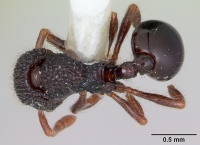Lachnomyrmex platynodus
| Lachnomyrmex platynodus | |
|---|---|

| |
| Scientific classification | |
| Kingdom: | Animalia |
| Phylum: | Arthropoda |
| Class: | Insecta |
| Order: | Hymenoptera |
| Family: | Formicidae |
| Subfamily: | Myrmicinae |
| Tribe: | Attini |
| Genus: | Lachnomyrmex |
| Species: | L. platynodus |
| Binomial name | |
| Lachnomyrmex platynodus Feitosa & Brandão, 2008 | |
The only known Lachnomyrmex platynodus specimen was collected in a leaf litter sample from a sub-montane wet forest (1300m) at Mt. Ayanganna, Guyana.
Identification
Feitosa and Brandão (2008) - Body predominantly blackish and irregularly rugose; promesonotum strongly convex and elevated well above propodeum level; metanotal suture obsolete; teeth of propodeal spines relatively thin; petiolar node dorsally flat, without a posterior slope; postpetiolar dorsum only minimally convex and mostly smooth; first tergite of gaster with around five long flexuous hairs. This species is known only by the holotype; however, it is unlikely to be confounded with any other congener. The combination of blackish color, dorsum of waist predominantly smooth, petiolar node flat, and first gastral tergite with a few sparse hairs is unique in the genus.
Keys including this Species
Distribution
Distribution based on Regional Taxon Lists
Neotropical Region: Guyana (type locality).
Distribution based on AntMaps
Distribution based on AntWeb specimens
Check data from AntWeb
Countries Occupied
| Number of countries occupied by this species based on AntWiki Regional Taxon Lists. In general, fewer countries occupied indicates a narrower range, while more countries indicates a more widespread species. |

|
Estimated Abundance
| Relative abundance based on number of AntMaps records per species (this species within the purple bar). Fewer records (to the left) indicates a less abundant/encountered species while more records (to the right) indicates more abundant/encountered species. |

|
Biology
|
Castes
Known only from the worker caste.
Nomenclature
The following information is derived from Barry Bolton's Online Catalogue of the Ants of the World.
- platynodus. Lachnomyrmex platynodus Feitosa & Brandão, 2008: 34, figs. 13, 18 (w.) GUYANA.
Unless otherwise noted the text for the remainder of this section is reported from the publication that includes the original description.
Description
Worker
Holotype measurements. HL 0.72; HW 0.72; ML 0.22; SL 0.46; EL 0.14; WL 0.87; PSL 0.16; PL 0.35; PPL 0.19; GL 0.94; TL 3.28; CI 101; SI 63; OI 19.
Color predominantly black, with ferruginous reflections, appendages dark brown. Body covered by vermiculate, relatively sparse short rugae, forming irregular areolae on promesonotum; rugae somewhat longer and longitudinal on head dorsum, and slightly sparser on mesopleura and lateral surfaces of propodeum; mandibles with longitudinal striae barely visible and almost reaching the masticatory margin; lateral faces of petiole and postpetiole irregularly rugose; dorsum of petiolar node and postpetiole predominantly smooth, with a few short, fine irregular rugae. Abundant pilosity, except by dorsal surface of propodeum; dorsum of petiolar node and postpetiole each with more than 10 long hairs; first gastral tergite with around five long, sparse flexuous hairs.
Head as long as broad, with vertexal margin virtually flat; frontal lobes subquadrate; eyes with approximately five facets on maximum diameter. Promesonotum strongly convex in profile, elevated well above the propodeum level; metanotal groove obsolete, so that the promesonotum outline reaches the propodeum in a slight declivity; propodeal spines straight; teeth of propodeal lobes relatively thin, slightly surpassing propodeal spines half-length. In lateral view, petiolar node moderately elevated and flat, without a posterior slope; postpetiole somewhat elongate and only weakly convex, with sternite feebly projected.
Type Material
Holotype worker. GUYANA: Guyana Esequiba: Mt. Ayanganna, 5º22.483N 59º57.969W, 13.x.2002, T.R. Schultz, J. Lapolla, C. Marshall & R. Williams cols, no. 413878, specimen code CASENT0173881 [USNM].
Etymology
This is species is named after its flat petiolar node. From Greek, platy: flat and from Latin, nodus: node.
References
- Feitosa, R.M. & Brandão, C.R.F. 2008. A taxonomic revision of the Neotropical myrmicine ant genus Lachnomyrmex Wheeler (Hymenoptera: Formicidae). Zootaxa 1890, 1-49.

